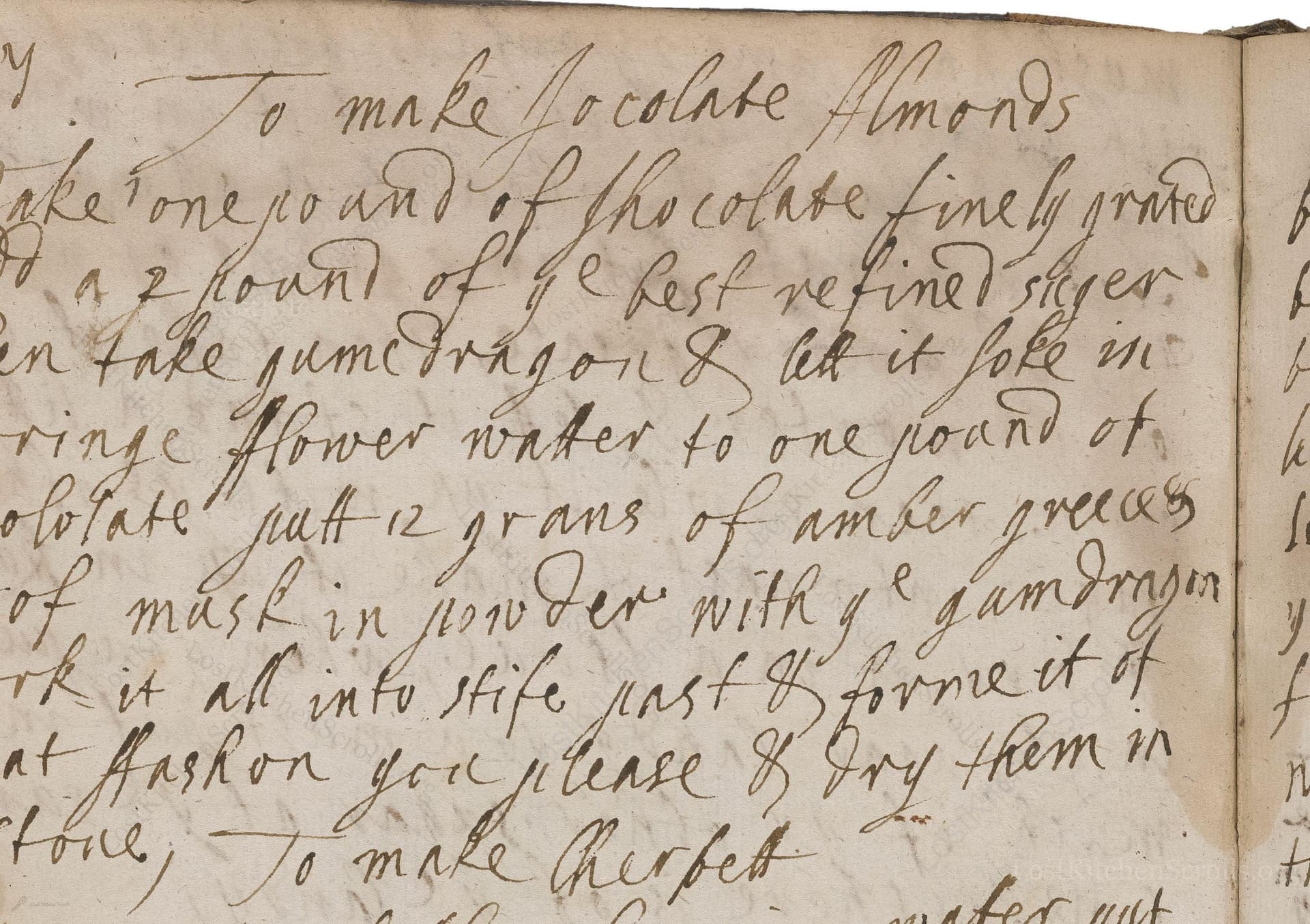To Make Chocolate Almonds
From the treasured pages of The Lady Grace Castleton's booke of receipts
Written by Grace Saunderson, Viscountess Castleton

To Make Chocolate Almonds
"take one pound of Choclate finely grated add a 2 pound of ye best refined shuger. then take sume dragon & let it soke in orringe flower water to one pound of Choclate putt 12 grans of amber greeces & of musk in powder with ye gumdragon work it all into stiff past & forme it of what fashon you please & dry them in a stove,"
Note on the Original Text
This recipe employs early modern English spelling and ambiguous measurements, typical for the era ('pound' and 'grans' for grains). 'Choclate' refers to the then-new European chocolate, which came in solid cakes. 'Gumdragon' is an old name for gum tragacanth, a natural thickener. Ambergris and musk, now exceedingly rare in food, were once prized for their aroma and supposed health effects; both are referenced in minute amounts. The prose assumes knowledge of basic kitchen technique—no baking temperature or time given—and reflects an oral tradition where skills were learned by watching, not reading.

Title
The Lady Grace Castleton's booke of receipts (1650)
You can also click the book image above to peruse the original tome
Writer
Grace Saunderson, Viscountess Castleton
Era
1650
Publisher
Unknown
Background
A delightful voyage into 17th-century English kitchens, this collection reveals the refined tastes and culinary secrets of the aristocracy, serving up a sumptuous array of period recipes and gracious domestic wisdom.
Kindly made available by
Folger Shakespeare Library
This recipe stems from 'V.a.600', a seventeenth-century English manuscript once belonging to Grace Saunderson, Viscountess Castleton (d. 1667). The 1600s in England saw the emergence of chocolate among the aristocracy, prized as an exotic luxury from the New World. Recipes like this reflect chocolate's transformation from a beverage to a confectionery item and reveal the fascination with rare, opulent ingredients (like ambergris and musk) thought to have medicinal or aphrodisiac qualities. Such confections would have graced the tables of England's elite during lavish banquets.

Cooks in the 17th century would have used a grater (likely of tin or pewter) to finely shred chocolate blocks. Mortars and pestles were essential for pulverizing spices and rare aromatics. Gum tragacanth would be softened in ceramic or wooden bowls. The stiff paste would be worked by hand or with wooden spoons and then shaped, perhaps using small wooden molds for uniformity. Drying would occur in a stove—essentially a gently warmed drying chamber or bread oven with residual heat, not direct fire.
Prep Time
20 mins
Cook Time
3 hrs
Servings
20
We've done our best to adapt this historical recipe for modern kitchens, but some details may still need refinement. We warmly welcome feedback from fellow cooks and culinary historians — your insights support the entire community!
Ingredients
- 1 lb (16 oz) dark chocolate (finely grated, minimum 70% cocoa, unsweetened recommended)
- 2 lb (32 oz) powdered white sugar
- 0.35 oz gum tragacanth (or gum arabic, as a substitute)
- 1 fl oz (2 tbsp) orange flower water
- 0.03 oz (about 1/32 oz, 12 grains) ambergris (substitute: a few drops of orange blossom essence or omit)
- A pinch of ground musk (substitute: a pinch of freshly ground nutmeg or omit)
Instructions
- To make Chocolate Almonds, begin by finely grating 1 pound (16 ounces) of high-quality, unsweetened chocolate.
- To this, add 2 pounds (32 ounces) of powdered white sugar.
- Soak 0.35 ounces (about 2 teaspoons) of gum tragacanth (used traditionally as a binding agent) in 1 fluid ounce (2 tablespoons) of orange flower water until it forms a mucilaginous mass.
- Add to the mixture 0.03 ounces (about 1/32 ounce, or 12 grains) of ambergris and a similar small pinch of musk, both ground into powder—these are aromatic substances, rare today, so food-grade substitutes or omitting them is acceptable.
- Work all the ingredients into a stiff paste (using clean hands or a sturdy spoon), then shape the paste into small almond-like forms or any other shape you like.
- Arrange these on a tray and dry in a warm oven (around 120°F) or a food dehydrator until firm, which may take several hours.
- Store in an airtight container once dried.
Estimated Calories
110 per serving
Cooking Estimates
It takes about 20 minutes to prepare the ingredients and mix them into a paste. Drying the shaped pieces in a warm oven takes several hours, typically about 3 hours. Each piece contains roughly 110 calories, and this recipe makes about 20 pieces.
As noted above, we have made our best effort to translate and adapt this historical recipe for modern kitchens, taking into account ingredients nowadays, cooking techniques, measurements, and so on. However, historical recipes often contain assumptions that require interpretation.
We'd love for anyone to help improve these adaptations. Community contributions are highly welcome. If you have suggestions, corrections, or cooking tips based on your experience with this recipe, please share them below.
Join the Discussion
Rate This Recipe
Dietary Preference
Main Ingredients
Culinary Technique
Occasions

Den Bockfisch In Einer Fleisch Suppen Zu Kochen
This recipe hails from a German manuscript cookbook compiled in 1696, a time whe...

Die Grieß Nudlen Zumachen
This recipe comes from a rather mysterious manuscript cookbook, penned anonymous...

Ein Boudain
This recipe comes from an anonymous German-language manuscript cookbook from 169...

Ein Gesaltzen Citroni
This recipe, dating from 1696, comes from an extensive anonymous German cookbook...
Browse our complete collection of time-honored recipes



